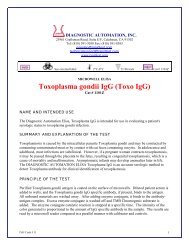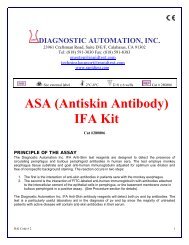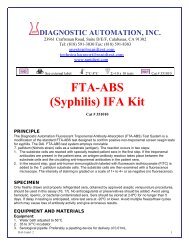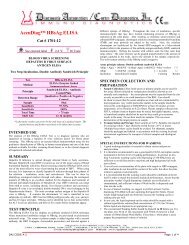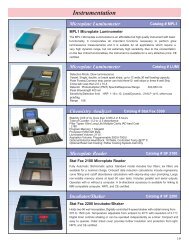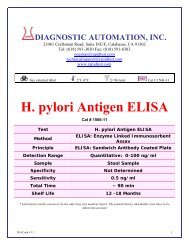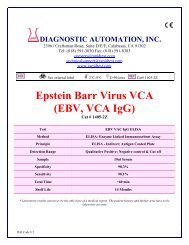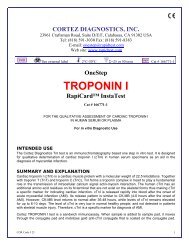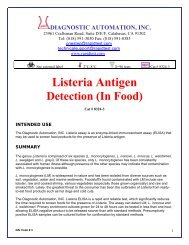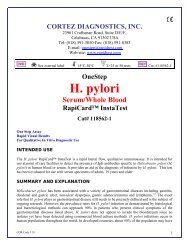Phencyclidine Urine - ELISA kits - Rapid tests
Phencyclidine Urine - ELISA kits - Rapid tests
Phencyclidine Urine - ELISA kits - Rapid tests
You also want an ePaper? Increase the reach of your titles
YUMPU automatically turns print PDFs into web optimized ePapers that Google loves.
CORTEZ DIAGNOSTICS, INC.<br />
23961 Craftsman Road, Suite D/E/F, Calabasas, CA 91302 USA<br />
Tel: (818) 591-3030 Fax: (818) 591-8383<br />
E-mail: onestep@rapidtest.com<br />
Web site: www.rapidtest.com<br />
See external label Σ=25 <strong>tests</strong> 2°C-30°C Cat # 121080-1<br />
OneStep<br />
<strong>Phencyclidine</strong> <strong>Urine</strong><br />
RapiDip InstaTest<br />
Cat # 121080-1<br />
FOR THE QUALITATIVE ASSESSMENT OF PHENCYCLIDINE<br />
IN HUMAN URINE<br />
For in vitro Diagnostic and Forensic Use<br />
INTENDED USE<br />
The Cortez Diagnostics, Inc. OneStep PCP RapiDip InstaTest is an immunochromatography based one<br />
step in vitro test. It is designed for qualitative determination of <strong>Phencyclidine</strong> in human urine specimens<br />
above a cut-off level of 25 ng/ml. This assay may be used in the point of care setting.<br />
This assay provides only a preliminary analytical test result. A more specific alternative chemical method<br />
must be used in order to obtain a confirmed analytical result. Gas chromatography/ mass spectrometry<br />
(GC/MS) has been established as the preferred confirmatory method by the Substance Abuse Mental<br />
Health Services Administration (SAMHSA). Clinical consideration and professional judgment should be<br />
applied to any drug of abuse test result, particularly when preliminary positive results are indicated.<br />
SUMMARY AND EXPLANATION<br />
<strong>Phencyclidine</strong>, commonly known as PCP, is a hallucinogen which interacts with dopamine, cholinergic and<br />
adrenergic systems. It has dose dependent stimulant, depressant, hallucinogenic and psychological<br />
effects. PCP is mostly administered by oral or intravenously. Even moderate amount of PCP, from 5 to 100<br />
ng/ml, can result in psychotic, violent and self-destruction. At high dose, from 100 to 500 ng/ml, PCP can<br />
cause convulsions, hypertion, and even death. PCP is metabolized via hydroxylation, oxidation, and<br />
conjugateion with glucuronic acid in the liver. About 10% of the dose is excreted in urine as unchanged<br />
drug. PCP can be detected in the urine for 7 to 8 days after drug administration. For chronic users, PCP<br />
may persist in urine for 2 to 4 weeks. However, the length of time following drug use for which a positive<br />
COR Code # 21 1
esult may occur is dependent upon several factors, including the frequency and amount of drug, metabolic<br />
rate, excretion rate, drug half-life, and the drug user’s age, weight, activity, and diet.<br />
TEST PRINCIPLE<br />
The Cortez Diagnostics, Inc. OneStep PCP RapiDip InstaTest is based on the principle of specific<br />
immunochemical reaction between antibodies and antigens to analyze particular compounds in human<br />
urine specimen. The assay relies on the competition for binding antibody between drug conjugate and free<br />
drug which may be present in the urine specimen being tested. When drug is present in the urine<br />
specimen, it competes with drug conjugate for the limited amount of antibody-dye conjugate. When the<br />
amount of drug is equal or more than the cut-off, 25 ng/ml, it will prevent the binding of drug conjugate to<br />
the antibody. Therefore, a positive urine specimen will not show a colored band on the test line zone,<br />
indicating a positive result, while the presence of a colored band indicates a negative result.<br />
A control line is present in the test window to work as procedural control. This colored band should always<br />
appear on the control line zone if the test device is stored in good condition and the test is performed<br />
appropriately.<br />
MATERIALS PROVIDED<br />
1. Instructions for use.<br />
2. Cortez PCP test device. The amount of each coated antigen and/or antibody on the strip is less than<br />
1.0 mg for antigen conjugate and is less than 1.0 mg for goat anti-mouse IgG antibody.<br />
Test zone: contains PCP bovine protein antigen conjugates.<br />
Control zone: contains Goat anti-mouse IgG antibody.<br />
3. Conjugate pad: contains mice monoclonal anti-PCP antibody.<br />
MATERIALS REQUIRED BUT NOT PROVIDED<br />
1. <strong>Urine</strong> collection container.<br />
2. Timer or clock.<br />
STORAGE AND STABILITY<br />
The test device should be stored at 2 to 30 o C and will be effective until the expiration date stated on the<br />
package. The product is humidity-sensitive and should be used immediately after being open. Any<br />
improperly sealed product should be discarded.<br />
PRECAUTIONS<br />
1. For in vitro diagnostic and forensic use only.<br />
2. Do not use the product beyond the expiration date.<br />
3. Handle all specimens as potentially infectious.<br />
4. Humidity sensitive product, do not open foil pouch until it is ready to be tested.<br />
5. Use a new urine specimen cup for each sample to avoid cross contamination.<br />
SPECIMEN COLLECTION AND PREPARATION<br />
It is required that approximately 150 µl of sample for each test. Fresh urine specimens do not need any<br />
special handling or treatment. Specimens should be collected in a clean, dry, plastic or glass container. If<br />
the assay is not performed immediately, urine specimen may be refrigerated at 2-8 o C or frozen up to 7<br />
days. Specimens should be thawed and brought to room temperature before testing. <strong>Urine</strong> specimens<br />
exhibiting a large amount of precipitate or turbidity should be centrifuged or allowed to settle before testing.<br />
Avoid contact with skin by wearing gloves and proper laboratory attire.<br />
COR Code # 21 2
QUALITY CONTROL<br />
Good Laboratory Practice recommends the daily use of control materials to validate the reliability of device.<br />
Control materials should be assayed as clinical specimen and challenging to the assay cutoff<br />
concentration, e.g., 25% above and below cutoff concentration. If control values do not fall within establish<br />
range, assay results are invalid. Control materials which are not provided with this test kit are commercially<br />
available.<br />
The Cortez Drugs of Abuse Test provides a built-in process control with a different antigen/antibody<br />
reaction at the control region (C). This control line should always appear regardless the presence of drug or<br />
metabolite. If the control line does not appear, the test device should be discarded and the obtained result<br />
is invalid. The presence of this control band in the control region serve as 1) verification that sufficient<br />
volume is added, 2) that proper flow is obtained.<br />
PROCEDURE<br />
1. Bring all materials and specimens to room temperature.<br />
2. Remove the test strip from the sealed foil pouch.<br />
3. Dip the strip into the urine specimen with the arrow pointing toward the sample. The sample level<br />
should not be higher than the arrow pointed maximum line.<br />
4. Hold the strip in the urine until a reddish color appears at the test area (approximately 20 seconds).<br />
5. Withdraw the strip and place it face up on a clean, non-absorptive surface or leave the strip in urine if<br />
the urine level is not higher than arrow pointed maximum line.<br />
6. Read the results at 5 minutes after adding the sample.<br />
Do not interpret the result after 5 minutes.<br />
INTERPRETATION OF RESULTS<br />
Negative:<br />
Two colored bands form. The appearance of two colored bands, one in test line zone and the other in<br />
control line zone, indicates negative results. The negative result indicates that the <strong>Phencyclidine</strong><br />
concentration in the specimen is either zero or less than cut-off level.<br />
Positive:<br />
One colored band forms. One colored band appears in control line zone. No colored band is found in test<br />
line zone. This is an indication that the <strong>Phencyclidine</strong> level in the specimen is above the cut-off level.<br />
Invalid:<br />
If there is no colored band in control line zone, the test result is invalid. Retest the sample with a new<br />
device.<br />
Note: A borderline (+/-) in test line zone should be considered negative result.<br />
LIMITATION OF PROCEDURE<br />
The assay is designed for use with human urine only. A positive result with any of the <strong>tests</strong> indicates only<br />
the presence of a drug/metabolite and does not indicate or measure intoxication.<br />
There is a possibility that technical or procedural error as well other substances in certain foods and<br />
medicines may interfere with the test and cause false results. Please refer “SPECIFICITY” section for lists<br />
of substances that will produce either positive results, or that do not interfere with test performance. If a<br />
drug/metabolite is found present in the urine specimen, the assay does not indicate frequency of drug use<br />
or distinguish between drug of abuse and certain foods and medicines.<br />
EXPECTED RESULTS<br />
The Cortez Diagnostics, Inc. OneStep PCP RapiDip InstaTest is a qualitative assay. It identifies<br />
<strong>Phencyclidine</strong> in human urine at a concentration of 25 ng/ml or higher. The concentration of the<br />
COR Code # 21 3
<strong>Phencyclidine</strong> cannot be determined by this assay. The test is intended to distinguish negative result from<br />
presumptive positive result. All positive results must be confirmed using an alternate method, preferably<br />
GC/MS.<br />
PERRFOMANCE CHARACTERISTICS<br />
A. Accuracy<br />
accuracy of the Cortez PCP test was evaluated in comparison to GC/MS at a cut-off of 25 ng/ml of<br />
phencyclidine. Ninety-nine urine specimens with GC/MS confirmed phencyclidine concentration were<br />
evaluated in this study. The results are summarized and presented below:<br />
Cortez PCP<br />
Test<br />
GC/MS<br />
Negative<br />
(less than<br />
–25%)<br />
(-) (+)<br />
Near cutoff Near cutoff<br />
negative positive<br />
(between –25% (between c/o<br />
and c/o and +25%<br />
GC/MS Positive<br />
(greater than<br />
+25%)<br />
Percent<br />
agreement with<br />
GC/MS<br />
Positive 1 0 5 36 97.6<br />
Negative 45 6 2 4 89.5<br />
Total 46 6 7 40<br />
Positive % agreement: 97.6, Negative % agreement: 89.5.<br />
Seven specimens were found discrepant between the Cortez PCP and GC/MS method. When compared<br />
those data, 28.6% (2 out of 7) of the discrepancy specimens were found between –25% and +25% cut-off<br />
concentration (18.8 – 31.3 ng/ml).<br />
B. Sensitivity<br />
The cut-off concentration (sensitivity level) of Cortez PCP test is determined to be 25ng/ml.<br />
C. Precision<br />
The precision study was performed by three individuals observing the test result to determine the random<br />
error of visual interpretation. The test results were found to have no significant differences between the<br />
three observers.<br />
Device Control Con. No. of Tested No. of positive No. of borderline # No. of negative<br />
ng/ml<br />
1* 2* 3* 1* 2* 3* 1* 2* 3*<br />
12.5 40 40 40 40<br />
18.8 40 40 40 40<br />
PCP 25 40 39 39 39 1 1 1<br />
31.3 40 40 40 40<br />
37.5 40 10 10 10 30 30 30<br />
D. Specificity<br />
The specificity for Cortez PCP testy was tested by adding various drugs, drug metabolites, and other<br />
compounds that are likely to be present in urine. All compounds were prepared in drug-free normal human<br />
urine.<br />
1. Interference testing<br />
The Cortez OneStep PCP RapiDip InstaTest performance at cut-off level is not affected when pH and<br />
Specific Gravity ranges of urine specimen are at 4.0 to 9.0 and 1.005 to 1.035.<br />
The following substances were tested and confirmed not to interfere with Cortez PCP test at the listed<br />
concentrations.<br />
COR Code # 21 4
Glucose<br />
Human albumin<br />
Human hemoglobin<br />
Urea<br />
Uric acid<br />
2000 mg/dl,<br />
2000 mg/dl<br />
10 mg/dl,<br />
4000 mg/dl<br />
10 mg/dl<br />
2. Specificity<br />
The following table lists compounds that are detected by Cortez PCP test which produced positive results<br />
when tested at levels equal or greater than the concentrations listed below:<br />
Compounds Con. (ng/ml)<br />
<strong>Phencyclidine</strong> 25<br />
Each listed substance that commonly found in the urine was evaluated and indicated negative result at<br />
concentration of 100 µg/ml.<br />
Acetaminophen 4-Acetamidophenol Acetylsalicylic acid Amikacin<br />
Amitriptyline Amobarbital Amphetamine Arterenol<br />
Aspartame Ascorbic acid Atrophine Caffeine<br />
Camphor Chloroquine Chlopheniramine Cortisone<br />
Deoxyephedrine Dextromethorphan Digitoxin Digoxin<br />
Diphenhydramine Ecgonine Ecgonine methyl ester Ephedrine<br />
Epinephrine Gentisic Guaiacol glycer ester Histamine<br />
Hydrochlorothiazide Homatrophine Imipramine Ibuprofen<br />
Isoproterenol Ketamine Lidocaine Meperidine<br />
Methadone Methamphetamione 3,4±MDMA Methaqualone<br />
Methylphenidate Neomycin Niacinamide Oxazepam<br />
Perphenazine Penicillin G Phenylethylamine-α Phenylpropanolamine<br />
Promethazine Pseudoephedrine Quinine antidine Salicylic aci Tetracycline<br />
Tetrahydrozoline Theophyline 11-nor-∆ 8 –THC-9-COOH ( 10 µg/ml)<br />
11-nor-∆ 8 –THC-9-COOH ( 10 µg/ml)Thioridazine Trifluoperazine Tryptophan<br />
Tyramine<br />
REFERENCES<br />
1. <strong>Urine</strong> testing for drugs of abuse, NIDA Research Monograph 73 (1986)<br />
2. Steven B. Karch, Drugs of abuse hand book, CRC Press, 1 st . Ed. (1998)<br />
3. Ray H. Liu and Bruce A. Goldberger, Handbook of workplace drug testing, AACC Press,<br />
Washington DC (1995)<br />
Date Adopted Reference No.<br />
2004-11-14 DA-<strong>Phencyclidine</strong>-2009<br />
CORTEZ DIAGNOSTICS, INC.<br />
23961 Craftsman Road, Suite D/E/F, Calabasas, CA 91302<br />
Tel: (818) 591-3030 Fax: (818) 591-8383<br />
ISO 13485-2003<br />
Revision Date: 1/21/09<br />
COR Code # 21 5



